Common oak horror
| Common oak horror | ||||||||||||
|---|---|---|---|---|---|---|---|---|---|---|---|---|

Common oak shrimp ( Meconema thalassinum ) ♂ |
||||||||||||
| Systematics | ||||||||||||
|
||||||||||||
| Scientific name | ||||||||||||
| Meconema thalassinum | ||||||||||||
| ( De Geer , 1773) |
The common oak shrimp ( Meconema thalassinum , syn .: Meconema varium ) belongs to the superfamily of leaf locusts (Tettigonioidea) in the subordination of long-feeler terrors (Ensifera).
features
The common oak shrimp is 1–1.5 cm tall when grown. This species looks like a smaller, paler version of the green hay horse . The antennae are about four times the body length (!) And are yellow with brown rings. The fore and hind wings protrude just above the tip of the abdomen. The abdominal appendages (cerci) are only weakly developed in the female and longer and curved inward in the male. This allows it to hold on to the female during mating. The females carry an almost full-length, slightly curved saber. A special feature of the grasshopper is the lack of stridulation organs in both Meconema species.
distribution
The common oak cricket has its distribution focus in Central Europe. To the east it goes to the Caucasus, to the north it spreads to Great Britain and southern Scandinavia, and to the south to northern southern Europe. In the USA it was introduced on Long Island. In Germany it shows neither a distribution limit nor any recognizable increase or decrease in the population.
habitat
The habitat is generally where oaks or other deciduous trees grow, i.e. primarily in deciduous forests, gardens, parks and orchards, also within localities. She avoids closed spruce, but also beech monocultures as well as areas with few trees and shrubs. The common oak shrimp usually hangs in the treetops, often sitting on the underside of leaves, only after heavy rains and storms can they be found on the ground, from where they soon return to the trees. Due to their ability to fly, it is easy for this species to colonize new habitats. But the animals can also run very quickly. They often get lost in apartments because they are also nocturnal and often come to light in the dark.
food
Their diet consists exclusively of insects , mostly aphids or small caterpillars.
Way of life
The oak terrors have developed a special kind of vocal expression, namely drumming with their hind legs on branches and coarser leaves. In return, they have lost the ability to stridulate using their wings. In terms of evolution, this is a very recent development that has not yet occurred in the closest relatives, the Japanese genus Nipponomeconema .
The relatively large eggs are laid in the bark of deciduous trees or on the galls of various gall wasps. It can take a year or two to develop. The eggs are very drought-resistant, even when hatching, in contrast to other leaf locusts, a reduced humidity is tolerated.
literature
- Reicholf-Riehm, Helgard: Insects; 1984, Munich

